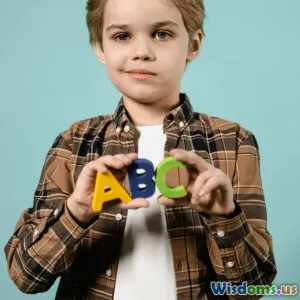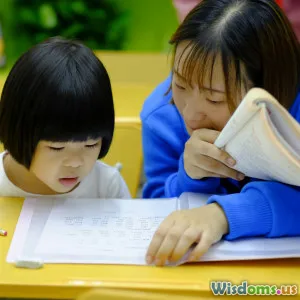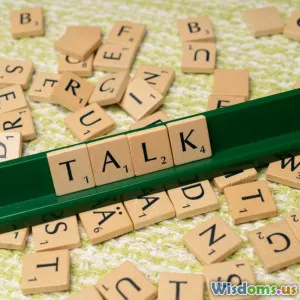
Why Do Some Kids Learn Two Languages Faster
9 min read Exploring why some children acquire two languages faster, revealing cognitive, environmental, and social factors. (0 Reviews)
Why Do Some Kids Learn Two Languages Faster?
Introduction: The Fascination with Bilingual Brilliance
Imagine a child effortlessly switching between two languages during playground conversations, seeming to understand and express themselves equally well in both. In a world that increasingly values multilingualism, the question of why some kids learn two languages much faster than others fascinates educators, parents, and researchers alike. Is it simply a matter of exposure, or are deeper cognitive, neural, and social factors at play? Understanding the intricacies behind this phenomenon can transform how we nurture bilingualism in children.
The Science Behind Bilingual Language Acquisition
Learning two languages simultaneously—often called simultaneous bilingualism—is a complex skill involving both environmental exposure and brain plasticity. While all children have an innate capacity for language acquisition, some excel faster due to a combination of factors.
1. Brain Plasticity and Critical Periods
One key reason some children learn languages faster relates to the brain's plasticity during early childhood. Neuroscientific studies reveal that children have a "critical period"—generally before puberty—when the brain is exceptionally receptive to new languages. This window allows children to develop native-like pronunciation, grammar, and intuition far more efficiently than adults. Adriana Abutalebi, a neuroscientist specializing in bilingualism, notes, "Early exposure reorganizes language centers in the brain, creating overlapping yet distinct pathways for each language."
In essence, kids exposed to two languages before age five often show faster acquisition due to these enhanced neural adaptations.
2. Cognitive Flexibility and Working Memory
Children who learn two languages faster often demonstrate superior executive functioning skills such as cognitive flexibility and working memory. These abilities enable them to switch between languages, suppress one language while speaking another, and manipulate linguistic information effectively.
A landmark study published in Developmental Science (2017) found that bilingual children who frequently switch languages perform better on tasks requiring attention control. This suggests that early bilingualism not only facilitates language learning but enhances cognitive processing that further accelerates language acquisition.
Environmental Factors Affecting Language Learning Speed
3. Quality and Quantity of Language Exposure
Exposure plays a crucial role, but it's not just about hearing two languages—it’s how and how much kids are exposed to each. Children immersed in rich linguistic environments with varied vocabulary, natural conversations, and interactive language use learn faster.
Consider a child raised bilingually with parents who deliberately use each language consistently in different contexts—one parent speaks English, the other Spanish. This method, known as the "one parent-one language" approach, provides children with clear linguistic boundaries, improving accelerated learning. Contrast this with cases where children only sporadically hear a second language through media or occasional family conversations; progress is typically slower.
4. Immersion and Social Interaction
Active social interaction serves as a powerful motivator and facilitator for language learning. Children placed in bilingual schools or bilingual social settings, where both languages are meaningfully used daily, absorb languages more quickly. Socializing compels children to practice both receptive (listening, reading) and productive (speaking, writing) skills.
For instance, a study in Language Learning (2020) highlighted that children attending dual-language immersion programs for two years exhibited near-native proficiency compared to peers receiving traditional ESL (English as a Second Language) instruction.
5. Parental and Community Support
Parents' attitudes, encouragement, and modeling of language use significantly influence acquisition speed. When families value bilingualism, celebrate usage, and provide resources such as books, games, and conversations in both languages, children feel supported.
Furthermore, community reinforcement—whether through bilingual community events, playgroups, or cultural festivals—helps entwine the languages with identity and purpose. Psychologist Ellen Bialystok, renowned for her bilingualism studies, emphasizes, "Motivation and positive social reinforcement are vital for children to continue expanding their bilingual skills beyond mere exposure."
Psychological and Motivational Factors
6. Children’s Attitudes Towards Languages
Children who see bilingualism as relevant, exciting, or useful are more motivated to learn faster. Positive attitudes create emotional connections, reducing anxiety around language mistakes. Coping with two languages can be challenging but children who are confident and curious tend to accelerate their learning.
7. Intrinsic vs. Extrinsic Motivation
Intrinsic motivation—learning because the child enjoys and values both languages—leads to deeper engagement and quicker acquisition compared to extrinsic factors like parental insistence or schooling alone. Encouraging playful, meaningful language activities nurtures this motivation.
Real-World Examples and Case Studies
Case Study: Matteo and Sofia’s Bilingual Journey
Matteo, a child growing up in Canada, speaks Italian at home and English at school. His sister Sofia shares the same environment but struggles more with Italian. The difference? Matteo’s parents interacted more exclusively in Italian, exposing him at a younger age and creating consistent language use occasions, including weekly Italian playdates and media.
This example underscores how early and meaningful immersion combined with social interaction fosters faster acquisition.
Global Examples
- In Switzerland, many children learn French, German, and Italian growing up, switching seamlessly due to structured school programs and societal bilingual integration.
- In India, children commonly grow up multilingual, navigating multiple regional languages because communities sustain usage alongside educational approaches.
These diverse settings highlight the role environment and community resources play across cultures.
How Parents and Educators Can Foster Faster Bilingual Learning
- Consistent Language Practices: Designate specific languages to parents or time blocks to establish clear language patterns.
- Engage Socially: Facilitate meaningful conversations and activities with bilingual peers or in bilingual settings.
- Leverage Technology and Media: Use age-appropriate apps, shows, and books that present both languages authentically.
- Encourage Positive Attitudes: Celebrate milestones and approach mistakes as learning opportunities.
- Stay Patient and Supportive: Recognize that bilingual language development can be uneven but ultimately beneficial.
Conclusion: The Unique Journey of Each Bilingual Child
The speed at which some children learn two languages faster is a nuanced interplay of brain development, quality of exposure, motivation, and social environment. While brain plasticity gives children a natural advantage, factors such as immersive environments, supportive communities, and positive attitudes greatly accelerate bilingual mastery.
Parents and educators who understand these elements can create enriching experiences that not only help children learn two languages quickly but foster a lifelong appreciation for cultural and linguistic diversity. After all, each bilingual child’s journey is unique—and with the right ingredients, it can be a remarkable journey of cognitive, social, and personal growth.
References:
- Abutalebi, A. (2018). Neural Foundations of Bilingualism.
- Bialystok, E. (2017). Bilingualism and Cognitive Control. Journal of Speech, Language, and Hearing Research
- Developmental Science, 2017; Language Learning, 2020
- Research on language immersion programs in Canada and Switzerland
Rate the Post
User Reviews
Popular Posts


















